According to 9to5Mac, Apple has extended the deadline for users to migrate from the old HomeKit framework to the new Apple Home architecture from fall 2025 to February 10, 2026. The company originally introduced the more reliable architecture several years ago and had planned to sunset the previous version this year. Users who haven’t updated by the new deadline may experience problems controlling connected accessories, and the update requires devices to be running iOS 16.2, iPadOS 16.2, macOS 13.1, tvOS 16.2, or watchOS 9.2 or later. The company’s support documentation emphasizes that all homes owned by a user update simultaneously when making the transition. This deadline extension reveals significant market dynamics at play.
Strategic Positioning in a Crowded Market
Apple’s decision to extend the transition timeline reflects the intense competitive pressure in the smart home space. While Apple has maintained its premium positioning, the company faces mounting challenges from Google’s Nest ecosystem and Amazon’s Alexa platform, both of which have achieved broader market penetration through more aggressive pricing and compatibility strategies. The extension suggests Apple recognizes it cannot afford to alienate its existing HomeKit user base during this critical market consolidation phase. As the smart home market matures, platform loyalty becomes increasingly fragile, and forced migrations risk driving users toward competitors with less stringent upgrade requirements.
The Legacy Compatibility Conundrum
This deadline pushback highlights a fundamental challenge facing all smart home platform providers: managing legacy device compatibility. Unlike smartphone apps that can be updated automatically, smart home ecosystems involve numerous third-party devices with varying update capabilities and product lifecycles. Many HomeKit-compatible devices from early adopters may lack firmware update paths to support the new architecture, creating a potential hardware obsolescence issue. The requirement for specific operating system versions further complicates migration, as users with older Apple devices may find themselves locked out of the ecosystem entirely. This creates a delicate balancing act between technological progress and user retention that even Apple struggles to navigate perfectly.
Broader Industry Implications
The extension signals to the entire smart home industry that even well-resourced platforms face adoption hurdles with architectural transitions. Third-party accessory manufacturers who’ve invested in HomeKit compatibility now receive additional breathing room to manage their product roadmaps and customer communications. However, it also creates uncertainty about Apple’s long-term commitment to backward compatibility standards. Competitors may seize this opportunity to highlight their own migration policies as more user-friendly. The move could also influence how other tech giants approach their own smart home platform evolutions, potentially leading to more gradual transition timelines across the industry.
The User Experience Calculus
Apple’s decision reflects a crucial recognition that smart home reliability is paramount—users tolerate far less instability in systems that control their physical environment compared to smartphones or computers. Forcing a migration that could potentially disrupt home automation, security systems, or climate control represents a significant brand risk. The company’s caution suggests they’ve encountered more complex technical challenges or user resistance than anticipated during the transition. This careful approach, while potentially frustrating for users seeking the promised reliability improvements, ultimately serves Apple’s reputation for delivering polished experiences, even if it means delaying promised features.
What Comes After February 2026
Looking beyond the new deadline, this extension period provides Apple with valuable data about user migration patterns and pain points. The company likely aims to use this additional time to refine its migration tools and address compatibility issues that have emerged during the initial rollout. The success or failure of this extended transition will also inform Apple’s approach to future smart home platform evolutions, including potential Matter standard implementations. As the smart home market continues to evolve toward greater interoperability through standards like Matter, Apple’s handling of this architecture transition will serve as a critical case study in balancing innovation with ecosystem stability.




